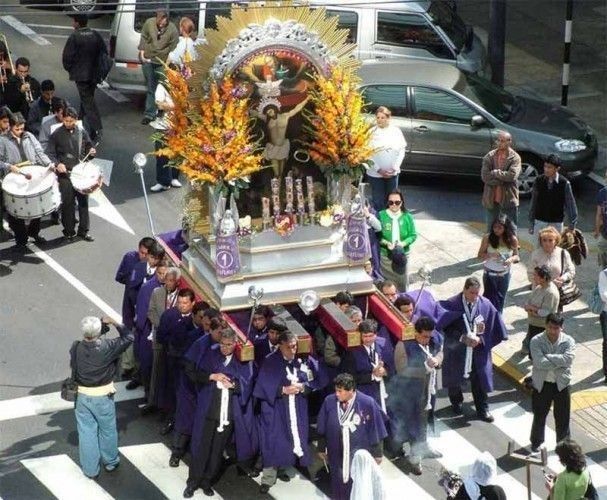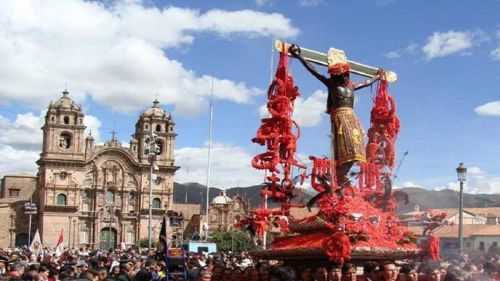October is the purple month in Lima and Limeños pay homage to their most venerated religious figure: El Señor de los Milagros, also known as Cristo de Pachacamilla. Often dressed in purple frocks, worshippers carry an image of the Lord of Miracles, the patron saint of Lima, in huge processions throughout the city.
The Lord of Miracles - how a simple painting became the largest procession in Latin America
According to religious belief, in 1651, an Angolan slave painted an image of a black Jesus Christ on a wall of one of the barracks in his neighborhood. As usual for christianized Africans, a few slaves soon worshipped the painting by night, praying and bringing offerings. In 1655, a heavy earthquake struck Lima, leaving the city reduced to rubble. It is said that the only thing still standing was the wall where a few years earlier the Angolan slave had painted the Christ image. Since then, the adoration for the painting flourished.
Soon devotion for the Christ image annoyed the Viceroyalty. Despite all attempts to remove the image and paint over it, the image stayed intact. In 1687, another earthquake hit Lima, once again destroying much of the colonial city center, including the chapel that had been built around the Christ image. But once again, the one wall with the image remained untouched.
Soon after the tremor, a copy of the Christ image was made and carried around town. The cult and adoration for the Lord of Miracles was born. When the image of the Lord of Miracles once again survived the massive 8.6 earthquake and devastating tsunami on October 28, 1746, which destroyed Lima and everything else along the central Peruvian coast, the adoration for El Señor de los Milagros reached new heights and increased even further over the centuries.
Since then, each year in October faithful believers carry the 2-ton altar with a copy of the painting of the Lord of Miracles on their shoulders from the Convent and Church of Las Nazarenas through Lima’s historic city center and other districts of the metropolis, singing hymns and praying.
It is custom that the first of many processions takes place at the beginning of October, however, the date varies. The altar leaves the Monastery of the Nazarenas and is carried through the historic city center of Lima before returning to his home. Usually thousands of devotees, many of them dressed in purple frocks, from all races and economic backgrounds, take part in this first religious procession.
The second procession is normally on or around mid-October (dates vary, so please confirm) and includes a visit to the Church of San Francisco in Lima’s city center. The image spends the night at the Nuestra Señora de las Victorias church from where the Lord of Miracles makes his third journey through the streets of Lima the next day.
Processions in many districts of Lima follow and are usually accompanied by a huge number of worshippers. And even less devout people pay their respect and let the Lord bless them, their family and home.
On the last Friday of the month, the principal day of the celebrations, the huge altar once more is carried through the city center, this time including the district of Breña. With a small procession around the Convent and Church of the Nazarenas, Peru's most revered religious icon bids farewell at the beginning of November and returns home to his place within the convent, where he usually stays from November to September of the next year.
To this day, the Lord of Miracles is believed to cure the sick and protect against earthquakes. As the traditional habit of the Nazarenas nuns, who protect the image, is to wear purple, October is considered the purple month in Lima and many female believers wear purple the whole month.
And to even further honor the Lord of Miracles for the entire month, typical Peruvian October dishes and sweets, such as the famous Turron de Doña Pepa, are sold on the streets.





























